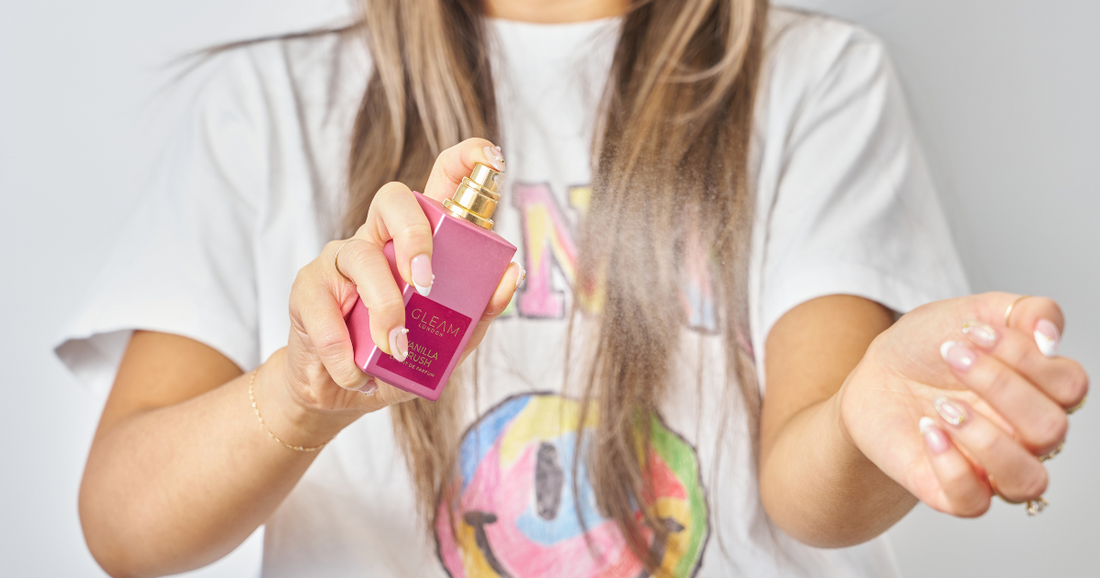
What’s the Difference Between Perfume and Cologne?
“Perfume” and “cologne” get thrown around a lot, but most people don’t realize they’re talking about fragrance strength, not gender. So by understanding the difference between cologne and perfume, you’ll choose the right formula for your lifestyle.
Cologne vs. Perfume
The real difference between cologne and perfume comes down to the concentration of aromatic compounds. That’s a fancy way of saying how much fragrance is in the formula compared to alcohol and water.
Here’s how it breaks down:
- Parfum (or Extrait de Parfum): The highest concentration.
- Eau de Parfum (EDP): Still strong but slightly lighter than parfum.
- Eau de Toilette (EDT): It’s fresh and lighter on the skin.
- Eau de Cologne (EDC): It’s the lightest version.
Think of it like this: parfum and cologne are on a scale and aren’t categories. You’re choosing how long you want the scent to last, how noticeable it should be, and when you’ll wear it.
Debunking the Gender Myth
Let’s clear up one of the biggest misconceptions in fragrance: “perfume” isn’t just for women, and “cologne” isn’t only for men.
These terms describe concentration, not gender.
The confusion mainly comes from marketing. In the U.S., brands often label men's fragrances as “cologne” and women’s as “perfume.” But that’s not how it works.
Historically, cologne referred to a specific fragrance style from Cologne, Germany, known for being light, citrusy, and fresh. Over time, the term started being used more broadly to describe any lighter fragrance, especially those with lower concentrations (around 2–5% aromatic compounds).
In contrast, perfume (or more accurately, parfum or eau de parfum) meant something more concentrated and long-lasting.
So when comparing perfume vs cologne, the real question is: How strong do you want your scent to be? Not whether it’s "for him" or "for her."
Bottom line: Wear what smells good to you. Whether labeled “cologne,” “perfume,” or something else entirely, the right fragrance fits your mood, skin, and style, not a marketing label.
Check out What’s the Difference Between Men’s and Women’s Fragrances for a deeper dive.
Understanding Fragrance Concentrations
Let’s break down the different scent concentrations.
Eau de Cologne (EDC) – 2–5% aromatic compounds
This is the lightest concentration. EDCs are fresh and airy, perfect for a quick refresh or hot summer days. They usually last a few hours and often come in larger bottles for generous application.
Eau de Toilette (EDT) – 5–15%
A step up in strength. EDTs are bright and versatile, making them a go-to for daily wear. They typically last 3–5 hours and are easy to reapply if needed.
Eau de Parfum (EDP) – 15–20%
Richer and longer-lasting. Most luxury and niche fragrances fall into this category. EDPs usually wear well for 6–8 hours and carry more depth and complexity.
Parfum (or Extrait de Parfum) – 20–30%
The most concentrated form, parfum, is bold and long-wearing, best for those who want their fragrance to linger from morning to night. Just a drop or two can last 8–12 hours or more.
When comparing parfum vs. cologne vs. toilette, remember this: the scent itself doesn’t change. Whether you’re wearing a cologne or a parfum version of the same fragrance, the top, middle, and base notes are the same.
What does change is the intensity and how long it stays on your skin. A cologne might offer a lighter, fleeting impression of the scent, while a parfum version delivers deeper wear and a more noticeable trail.
Read Understanding Top, Heart, and Base Notes in Perfume and What Are the Different Perfume Strengths for more.
How to Choose the Right Strength for Your Lifestyle
Picking the right fragrance concentration isn’t just about how it smells. It’s about how it fits into your day.
Here’s how to match scent strength with your routine:
1. Go lighter for daily wear.
If you’re heading to work, running errands, or spending time in close quarters, a lighter concentration like Eau de Cologne or Eau de Toilette is a solid choice.
These formulas feel fresh and won’t overwhelm a room. They’re ideal for quick mornings or situations where a subtle scent is best. Just keep in mind, they usually last 2–5 hours, so you might want to reapply midday.
2. Choose stronger scents for long days or nights out.
For events, date nights, or days when you want your fragrance to last from morning to evening, reach for an Eau de Parfum or Parfum.
These higher concentrations have more depth and sillage (that’s the scent trail a fragrance leaves behind). They linger longer (often 6 to 12 hours) and evolve as you wear them, revealing different notes over time.
3. Think about your scent style.
If you prefer a soft, close-to-the-skin fragrance, go for something lower in concentration. If you love a bold, noticeable presence, parfum is your power move. It all depends on how you want your scent to interact with the space around you.
No matter what you choose, the best fragrance strength is the one that suits your pace, your space, and how you like to wear your scent.
For help putting on your perfume or cologne, read How to Properly Wear Perfume for Women and Men.
Fragrance Strength Over Label
At the end of the day, choosing between perfume or cologne isn’t about gender. It’s about how much scent you want and how long you want it to last. Because the best choice is the one that fits your routine, preferences, and style.
Explore So Avant Garde’s luxury and niche fragrances collection to experience the difference for yourself.
Try a few concentrations, play with your scent wardrobe, and find the one that feels just right. Your signature scent is waiting.


